In this article, I present the United States Court of Appeals for the Fifth Circuit decision in case No. 21-60743 relating to the rejection of a license to store spent nuclear power plant rods from out of state in a facility in Texas.
It is a long decision as court decisions usually are. It may be a strange way to introduce the enormous topic of the storage of nuclear waste. There are two main types of nuclear waste:
A. Related to Nuclear Weapons
B. Related to Nuclear Fission Energy Plants (this case is related to this category of nuclear waste but the two topics are very intertwined)
There are other minor categories including medical.
The common characteristic in all categories of nuclear waste is generally no one wants to store it. There are many reasons for that. Some are obvious. By no one, I mean no states. Some communities see the storage of nuclear waste as an economic development opportunity.
I am reporting on this decision mostly because it is recent and addresses the state’s rights aspects of the problem. If you read the decision carefully, you will glean additional information.
I will summarize some of that at the end of the article.
I know that court decisions are boring but this topic is very important. Some of the environmental issues were touched in this decision but the issue of the transport of nuclear waste and the risk this creates was only hinted at.
This is a large problem for the U.S. and many other nations and I have had difficulty addressing it because of all the complications and the large amount of information that is important to understand. In this case, the focus was on legal issues so it was perhaps a good way to introduce the topic. The legal issues are extremely important but the technical issues are also extremely important. I will be getting into those in future articles and I plan to write a number of articles on this topic because of its importance.
At the end of the article, there is an opportunity to submit comments and I encourage readers to do so. It is usually better to submit a comment that way than to me directly because more people will see the comment and responses by me and others to the comment will also be seen by others. So it stimulates discussion. Please feel free to send this article to anyone who you think will benefit from reading it.

I provide a link to the full Court Opinion later in the article. But I have reproduced it in this article page by page with my comments after each page. My comments are primarily what I thought was important in each of the 26 pages of the Appeals Court Panel decision.
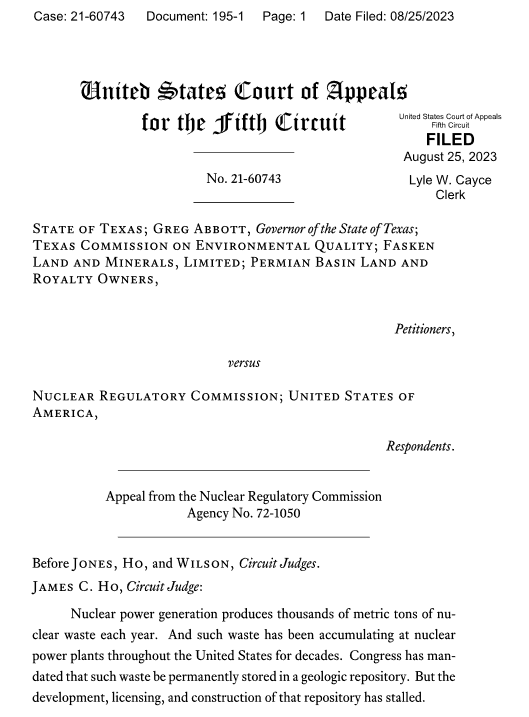
| This is the introduction. |

| Notice the key entities involved namely the Nuclear Regulatory Commission and the Atomic Energy Act. I am only mentioning the Federal Entities here because this is a struggle between the Federal Government and the States. It is a State’s Rights Issue. Are States required by the Federal Government to store nuclear waste? In this case, it is more narrow as Texas is only complaining about storing out-of-state generated nuclear waste. At this point, I want to make it clear that in writing on the subject of nuclear waste I am primarily presenting the problem and the issues and not my opinions on what the decisions should be. I have an engineering background so any opinions I express relative to the engineering aspects would be in my opinion consistent with good engineering practice. I am not opposed to the U.S. having the military capability to protect the United States. So hopefully, and it is always my intention, my writings are ideology-free other than a respect for the Laws and Institutions of the United States. |
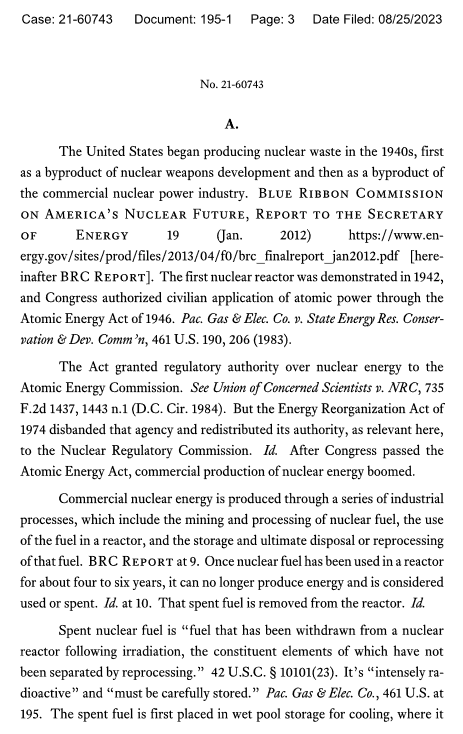
| Useful background information |
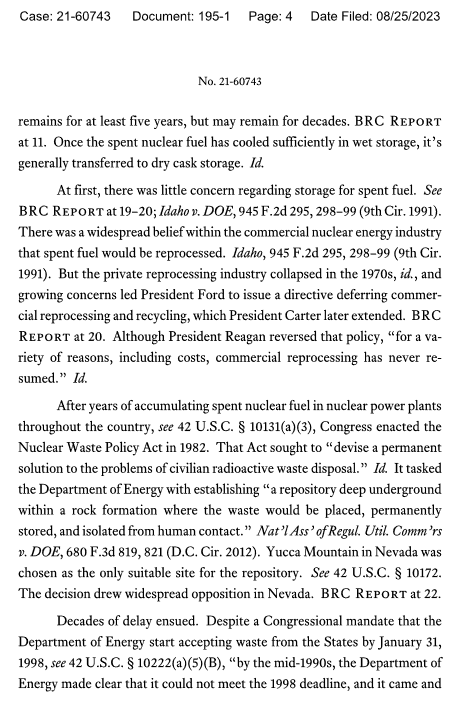
| We will discuss Yucca Mountain in a subsequent article. But you can start to see the long history of trying to deal with this problem. In this section, we learn about the role of the U.S. Department of Energy. |

| “Spent nuclear fuel continues to accumulate at reactor sites across the country. Some estimates suggest the U.S. inventory of spent nuclear fuel may exceed 200,000 metric tons by 2050. BRC REPORT at 14. The commercial nuclear power industry as a whole is estimated to generate between 2,000 and 2,400 metric tons of spent nuclear fuel each year. Id. And there are thousands of metric tons of spent fuel in various sites where commercial reactors no longer operate. Id.” |

| Local interest in the economic development potential of having a waste storage facility in their area, National Environmental Policy Act; Concerns rise that the application states as temporary will lead to it being a permanent repository. Another entity surfaces in the discussion: the Atomic Safety and Licensing Board. |

| “The Commission published a draft environmental impact statement in May 2020. The Commission received approximately 2,527 unique comments on the draft environmental impact statement, and many opposed the facility. One comment was a letter from Texas Governor Greg Abbott urging the Commission to deny the license application because of the lack of a permanent repository and the importance of the Permian Basin to the nation’s energy security and economy. ”
The lines are now drawn: Federal Interests versus State Interests versus Local Interests. |

| “The following September, the Texas Legislature passed H.B. 7. The statute makes it illegal to “dispose of or store high level radioactive waste” in Texas. Governor Abbott sent a letter to the Commission with a copy of H.B. 7. He reiterated that “the State of Texas has serious concerns with the design of the proposed ISP facility and with locating it in an area that is es essential to the country’s energy security.” The next day, Fasken submitted an environmental analysis critiquing various aspects of the final environmental impact statement. A few days later, the Commission issued the license.”
There may be a somewhat similar situation in New Mexico. |
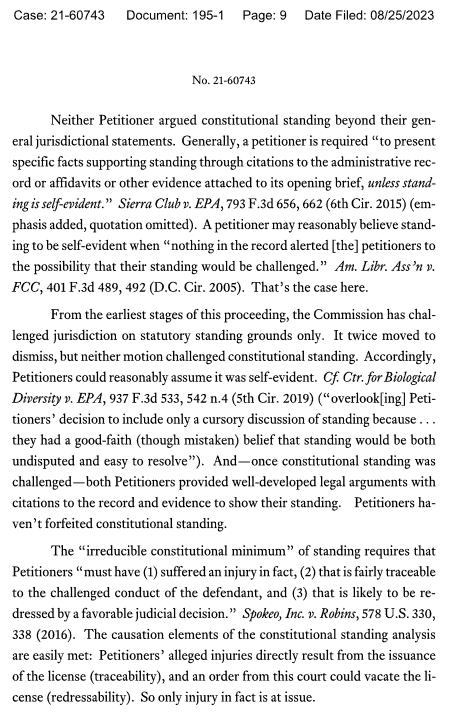
| The legal issues are clarified. |
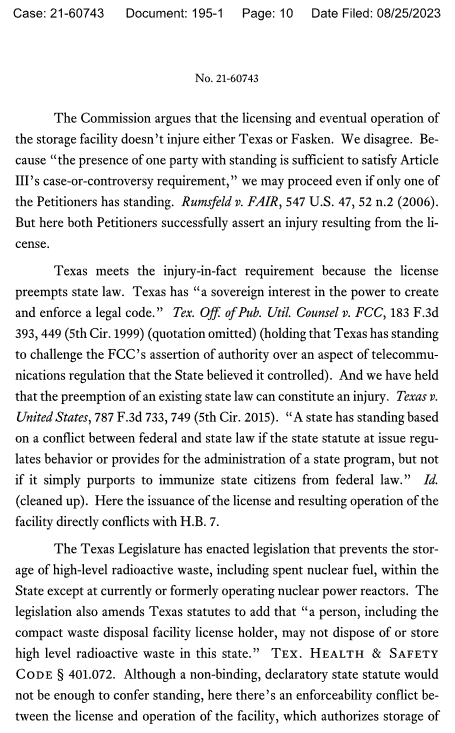
| Injury and standing are discussed. |
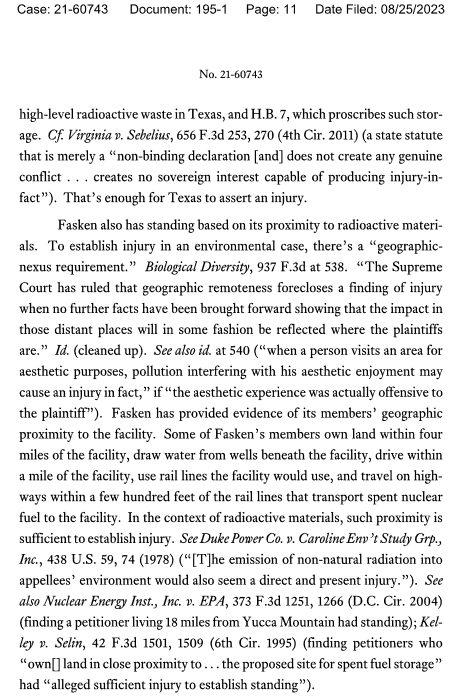
| The concept of proximity to the facility is raised. In a future article, I will be discussing the proximity to the conveyance route of radioactive waste. |

| Now it is time to introduce two Texas entities and another piece of Federal Legislation generally known as the Hobbs Act. This becomes important because as raised in the court decision:
“To address this problem, the Nuclear Regulatory Commission has asserted that it has authority under the Atomic Energy Act to license temporary, away-from-reactor storage facilities for spent nuclear fuel. Based on that claim of authority, the Commission has issued a license for Interim Storage Partners, LLC, a private company, to operate a temporary storage facility on the Permian Basin, in Andrews County, Texas. Fasken Land and Miner als, Ltd., a for-profit organization working in oil and gas extraction, and Permian Basin Land and Royalty Owners (“PBLRO”), an association seeking to protect the interests of the Permian Basin, have petitioned for review of the license.1 So has the State of Texas, which argues, inter alia, that the Atomic Energy Act doesn’t confer authority on the Commission to license such a facility.” Let us not forget Interim Storage Partners, LLC. Now you know why I have provided the court decision in its entirety as it is complicated. |
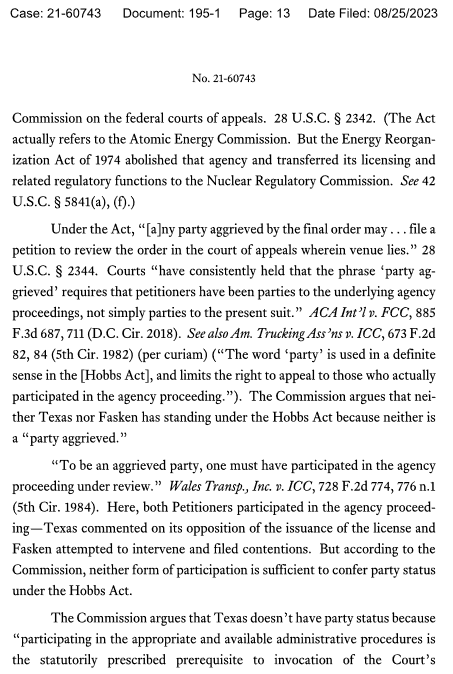
| Note the role of the Energy Reorganization Act of 1974. Again the discussion of standing here is described as aggrieved parties. |
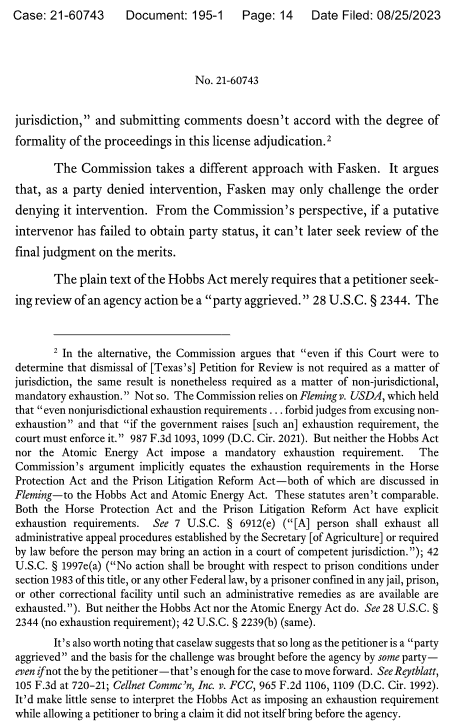
| More discussion of who can intervene etc. |
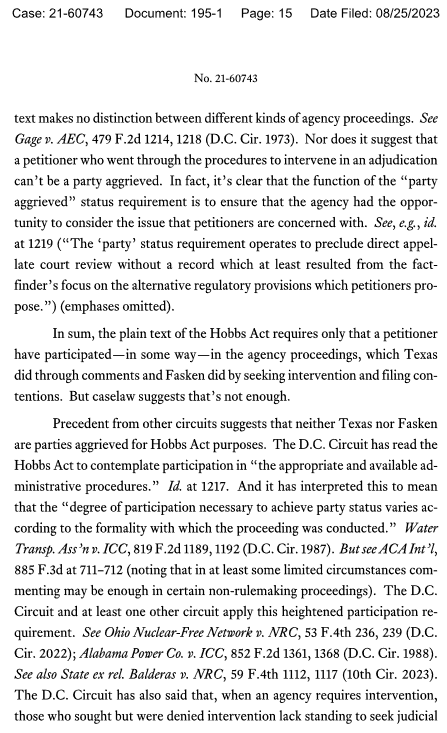
| This is important as it introduces precedents from other Circuits. This can be important on appeal. |
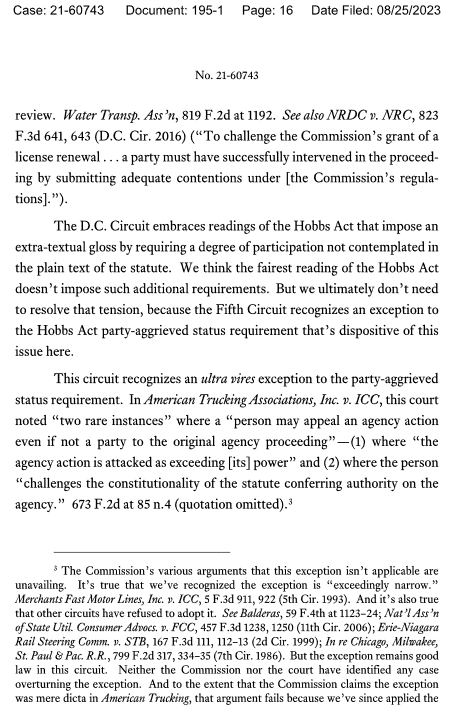
| But the Fifth Circuit recognizes an exception to the provisions of the Hobbs Act. “ultra” vires means going beyond the authority and is explained on the next page of the decision. So basically they are providing multiple reasons for their decision not being overturned. |

| Here the court starts to lay out the reasoning for its decision |

| Here in Section III the Court makes its case that the Commission did not have the authority to issue the license. To do that they have to arguments made or which could be made by the Commission. |

| More of the same. |
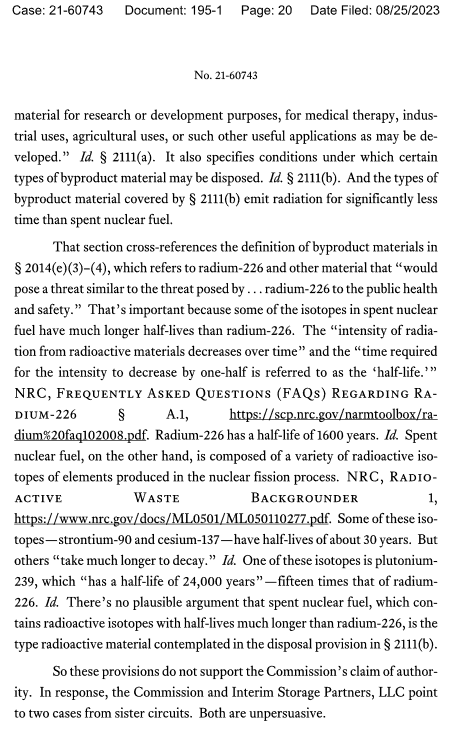
This page is very important and some of the information introduced is very important. “That section cross-references the definition of byproduct materials in
https://www.nrc.gov/docs/ML0501/ML050110277.pdf. Some of these iso topes-strontium-90 and cesium-137-have half-lives of about 30 years. But others “take much longer to decay.” Id. One of these isotopes is plutonium- 239, which “has a half-life of 24,000 years”-fifteen times that of radium-
The key to the argument here is that some of the material to be stored has a half-life of 24,000 years meaning it takes that long for the material to be 50% less radioactive. Here the argument is that some amount of the material to be stored is plutonium-239. In other articles I plan to write, the material to be handled starts with having a lot of plutonium-239. This is why temporary storage versus permanent storage becomes important and why the effectiveness and stability of the storage site and storage approach becomes so important. |
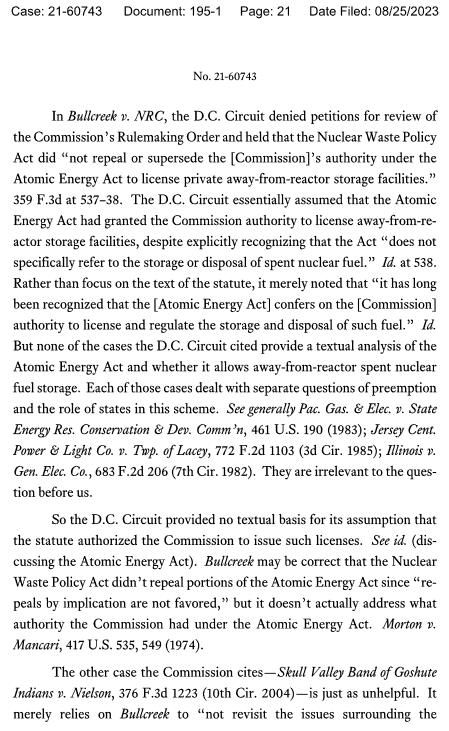
| Basically, the Fifth Circuit feels the need to discredit the interpretation of the D.C. Circuit. All of this is very important. |

| The Court is reminding us the Nuclear Waste Policy Act has failed but it made the federal government responsible for permanently disposing of spent nuclear fuel and high-level radioactive waste produced by civilian nuclear power generation and defense activities. The court is reminding us that this is the responsibility of the federal government, not individual states. |
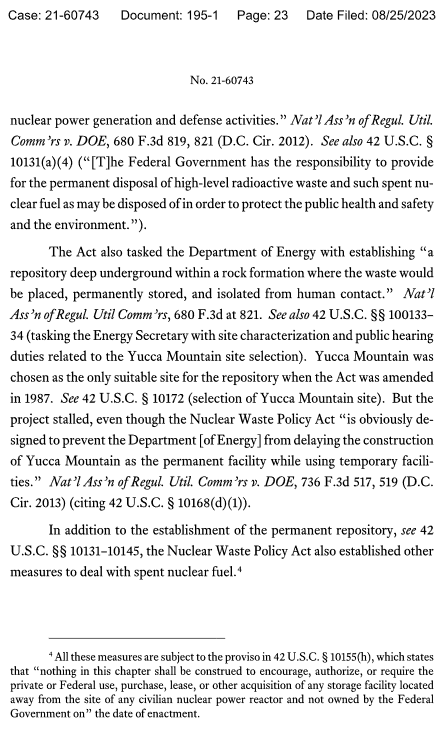
| The Court is also reminding us that the Nuclear Waste Policy Act called for the establishment of a permanent repository not a set of temporary storage repositories which might simply evolve into permanent repositories even if not designed to perform that function. |

| Here the Court reminds us that temporary storage be primarily by those that own and operate civilian nuclear power reactors. There is a provision for not more than 1,900 metric tons of interim storage to deal with situations where those who own and operate civilian nuclear power reactors are not able to temporarily able to store their spent nuclear fuel but this interim storage must be retrievable. The subsequent wording is not as clear as one might like but it applies to the issue (and now revoked) license to Interim Storage Partners. |
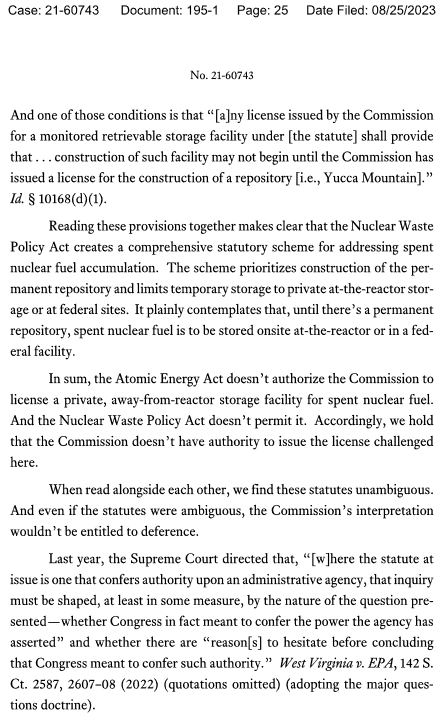
| The Court reinforces its argument that the decision to issue a license by the Commission was beyond its authority. It also refers to support for its approach by a recent Supreme Court decision suggesting to me at least that they think this case is headed there. In so doing it provides potentially a preview of arguments that will be made by the Nuclear Regulatory Commission and possibly other appellants. My reasons for thinking this decision will be appealed is not related to the fact that the decision was by a panel of judges rather than en banc but that the problem is important for all states but especially Texas and New Mexico which I will address in a future article. The stakes are high and it is IMO a narrow decision (That might be considered in conflict with decisions by the District of Columbia Appeals Court) and more than likely the U.S. Congress will have to get involved. This article shows the court opinion in its entirety but a link to the court opinion can be found HERE. |
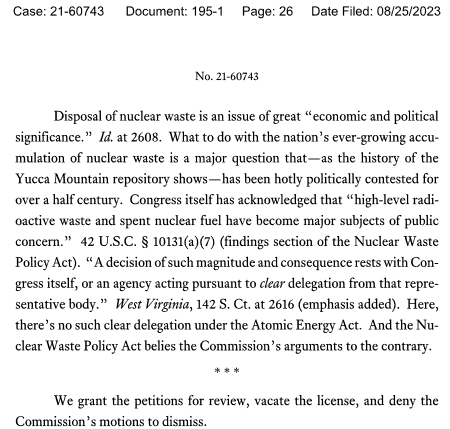
| This repeats the decision but also summarises the issue: “Disposal of nuclear waste is an issue of great “economic and political significance.” Id. at 2608. What to do with the nation’s ever-growing accumulation of nuclear waste is a major question that-as the history of the Yucca Mountain repository shows, has been hotly politically contested for over a half-century. Congress itself has acknowledged that “high-level radioactive waste and spent nuclear fuel have become major subjects of public concern.” 42 U.S.C. § 10131(a)(7) (findings section of the Nuclear Waste Policy Act). “A decision of such magnitude and consequence rests with Congress itself, or an agency acting pursuant to clear delegation from that representative body.” West Virginia, 142 S. Ct. at 2616 (emphasis added). Here, there’s no such clear delegation under the Atomic Energy Act. And the Nuclear Waste Policy Act belies the Commission’s arguments to the contrary. |
–
| I hope you found this article interesting and useful. I will be writing more articles on this topic. |
–